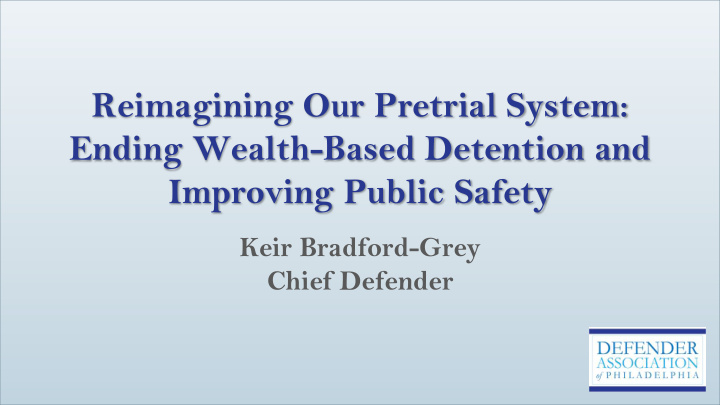



Reimagining Our Pretrial System: Ending Wealth-Based Detention and Improving Public Safety Keir Bradford-Grey Chief Defender
Structure of this presentation 1. Our animating principles in imagining a new system 2. Our vision for a new pretrial system 3. Rule changes 4. Questions
Goals Goals End wealth-based detention ● Provide individuals the opportunity for robust, individualized hearings ● Connect individuals with community-based services and supports as early as possible ● Focus on creating customized pretrial plans to reduce risk of pretrial noncompliance ● Prevent unnecessary pretrial detention ● Improve public safety ● Save money ●
Issue Summons for Low-Level Charges Issue summons for low-level charges Instead of clogging up the preliminary arraignment process with low-level charges where ROR will almost certainly be granted, issue summons. Philadelphia is currently the only county that cannot issue summons for low-level charges ● Allows for more time to be spent in preliminary arraignment on more serious charges ● Summons would include instances in which the most serious offense charged is a misdemeanor ● of the third degree, misdemeanor of the second degree, an ungraded misdemeanor punishable by a term of imprisonment of not more than three years, or a misdemeanor of the first degree in cases arising under 75 Pa.C.S. § 3802* *unless the defendant is charged with violating an order pursuant to 23 Pa.C.S. Ch. 61 (relating to protection from abuse) or the defendant poses a real and present threat of immediate physical harm to any other person or to himself or herself
Preliminary Arraignment In the instances where the DA’s office does not file a motion requesting detention, preliminary arraignment would serve as a robust conditions of release hearing. Individuals who are issued a summons would not go through preliminary arraignment ● Presumption of ROR would remain, as required by the Rules ● Defender would have opportunity to speak with client via video, similar to Pretrial Services, ● before preliminary arraignment and assign a bail navigator to clients who need support Creates more time to focus on release conditions and how to ensure pretrial success ● The summons process eliminates preliminary arraignment hearings for those who would ● otherwise get ROR When DA files a motion to hold without bail, in-depth scrutiny is deferred ● to the release determination hearing within two business days Work with stakeholders to craft guidelines regarding conditions of release ●
DA Motion to Detain If the DA’s Office believes an individual is dangerous or such a flight risk that they must be detained, a written motion must be filed at the time of preliminary arraignment. If the DA does not file a motion to hold without bail at preliminary arraignment, an ● individual must be released, with or without conditions If a motion is filed, bail magistrates will schedule a release determination hearing ● before an MC judge within two business days of preliminary arraignment Consult with partners to craft criteria regarding instances in which a motion to hold ● without bail can be filed
Release Determination Hearings Robust, adversarial, in-person hearings when DA has filed a motion to hold without bail. In-person hearing presided over by MC judge, similar to Early Bail Review ● DA’s office will have opportunity to present evidence as to the individual’s flight risk ● and dangerousness Defender will have opportunity to meet with/interview client before this hearing ● A single business day continuance request may be made by the defense or for the ● purpose of appointing defense counsel
Pre-Entry Model The Defender will build a team of pretrial advocates (similar to existing bail navigators) to ● meet with clients prior to release determination hearings Defender pretrial advocates will assess individual needs and coordinate with social service and ● community organizations to build individualized release plans connecting people to community- based supports This system will support pretrial success and address underlying issues that will assist a person ● when they return to the community Santa Clara County, California has implemented a similar community release with ● promising results: 95% of people released pretrial show up for court and 99% remain arrest-free
Proposed Rule Changes Change Rule 1003 to allow summons procedure to be used in Philadelphia County.
Proposed Rule Changes (cont.) Change Local Rule 520 to require robust conditions of release hearing at preliminary arraignment and the structure for motions to hold without bail and release determination hearings.
What Next? ● Input from other stakeholders ● Input from community groups ● Working through logistics/details of new system ● Submission of rule changes ● If approved, transition to new system
Questions? Questions
Recommend
More recommend